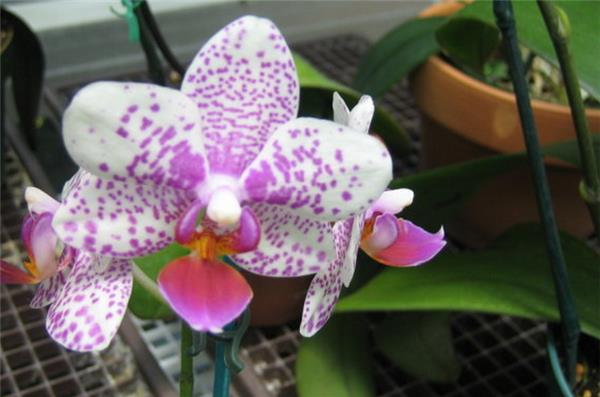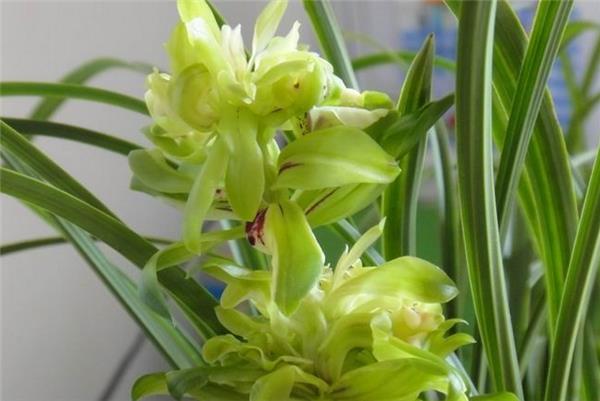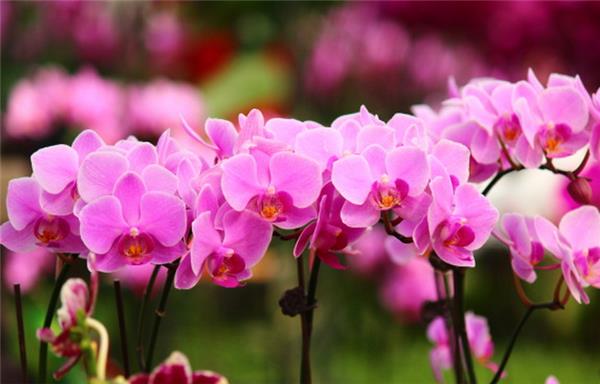[butterfly orchid] how to raise butterfly orchids
Phalaenopsis is a famous cut flower species, all belonging to more than 50 species. Single-stemmed epiphytic orchid, short stems, large leaves, one to several flowering stems, arched, large flowers, named because the flowers are shaped like butterflies. With beautiful flowers and gorgeous colors, it is a treasure of tropical orchids and has the reputation of "queen of orchid".

First, how to raise butterfly orchids
1. Cultivation place and temperature
When growing Phalaenopsis at home, the key point is to keep the temperature above 15 ℃, preferably in a place where 18 ℃ can be maintained. The lowest temperature should not be lower than 7 ℃. Below this temperature, the flowers will wither. In order to make the orchid plant accept the light, it is best to put it on the indoor windowsill and block the light with a window screen. After the weather turns warm, it can be moved to the outside, and pay attention to ventilation and shading to avoid continuous high temperature above 33 ℃.
2. Watering and humidity
If the cultivation medium is in a moist state for a long time, the roots of Phalaenopsis will rot, the leaves will turn yellow, and serious ones will die. The principle of seeing dry and wet should be grasped. If the water moss is too wet for a long time after watering, the plant can be taken off and exposed in the air, and then re-implanted in the basin after the plant is slightly dry. The water temperature had better be close to the room temperature. It is best to use a humidifier to increase air humidity, you can also use a sprayer to spray mist on the leaves, but be careful not to spray water mist on the flowers.

II. Matters needing attention in the culture of butterfly orchids
1. Pay attention to the selection of suitable cultivation medium. Seaweed substrates such as aquatic plants and moss with high permeability and soil and water conservation nutrients are generally selected. If the cultivation time is too long (more than 2 years), the substrate should be changed timely, and the time should be chosen when the new leaves are released.
2. Pay attention to ensure the suitable growth temperature. It grows best when the temperature is from 18 ℃ to 28 ℃, which can not be lower than 15 ℃ or higher than 33 ℃. When watering, the water temperature is close to the room temperature. During flowering, the temperature can be lowered appropriately and the flowering period can be prolonged.
3. Pay attention to the selection of suitable lighting environment. In summer, autumn and spring, the semi-overcast environment where there is no direct light is the best, and the southward sunny places are placed in winter.
4. Pay attention to mastering the principle of reasonable fertilization. Fertilize less, apply light fertilizer; usually apply special fertilizer for orchids to the roots, about once a month. Apply phosphate fertilizer before flowering, once a week or so, foliar spraying; during flowering, when the temperature is low, fertilization is strictly prohibited; after flowering, cut off flower branches in time, strengthen fertilizer and water, root topdressing, can be once a fortnight.

Third, the function of butterfly orchid
1. Phalaenopsis has a strong role in beautifying the home environment. Its plants are very peculiar, with neither stolons nor pseudobulbs. Each tree produces only a few broad leaves as thick as a spoon, stacked alternately on top of the base. The thick white air root is exposed around the leaves, and some cling to the outer wall of the flowerpot, which is full of natural wild interest. In the Spring Festival, a foot-long pedicel is drawn from the axils of the leaves and blossoms one by one. Each flower has 5 dusks, with lip flaps embedded in the middle. The flowers are bright, including pure white, goose yellow, tripping red, lilac, orange red and azure blue. Many varieties have both two-color or tricolor, some seem to be embroidered with stripes, and some seem to be sprayed with uniform color spots, with seven or eight flowers per branch, and more than twelve or three, which can be watched continuously for 60 or 70 days. With such a beautiful appearance, do you still resist it?
2. Phalaenopsis can make the house full of life from the outside to the inside. The name "Phalaenopsis" has a connotation that many people do not know. Phalaenopsis's scientific name means "like a butterfly orchid" in Greek. It can absorb nutrients in the air and survive, proving its dynamic role in the center of the home, flying around in the air like a butterfly, vitality and vitality are produced here, and its appearance, although it will not move, but, so beautiful and dazzling, can add a lot of atmosphere to a home, like a festival, jubilant.

These are the breeding methods and precautions of butterfly orchids. We can see that it is not easy to raise a pot of butterfly orchids. We must take care of them carefully.
Related
- Wuhan Hospital Iron Tree Blooming Result Was Instantly Frightened by the Gardener Master
- Which variety of camellia is the most fragrant and best? Which one do you like best?
- What is the small blue coat, the breeding methods and matters needing attention of the succulent plant
- Dormancy time and maintenance management of succulent plants during dormancy
- Minas succulent how to raise, Minas succulent plant pictures
- What are the varieties of winter succulent plants
- How to raise succulent plants in twelve rolls? let's take a look at some experience of breeding twelve rolls.
- Attention should be paid to water control for succulent plants during dormant period (winter and summer)
- Watering experience of twelve rolls of succulent plants
- Techniques for fertilizing succulent plants. An article will let you know how to fertilize succulent plants.



